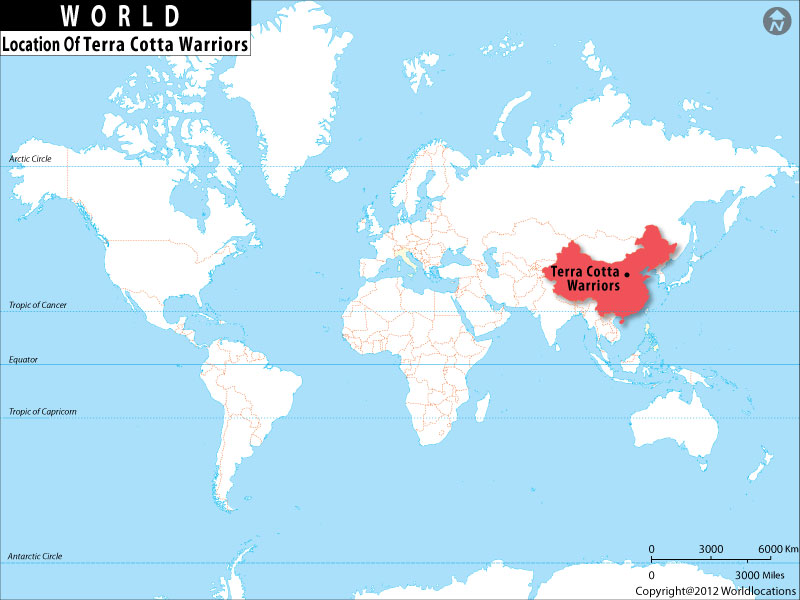The Terracotta Warriors are located in the city of Xi'an, in the Shaanxi province of China. Specifically, they are found in the Lintong District, which is about 40 kilometers (25 miles) east of Xi'an. The site is officially known as the "Emperor Qinshihuang's Mausoleum Site Museum" and is one of the most famous archaeological sites in the world. It houses the remarkable terracotta army, which consists of thousands of life-sized clay soldiers and horses that were buried with China's first emperor, Qin Shi Huang, to accompany him in the afterlife.
Location Map of Terracotta Warriors
 About Map: Map showing Where is Terracotta Warriors, located in the Map.
About Map: Map showing Where is Terracotta Warriors, located in the Map.
About Terracotta Warriors
The Terracotta Warriors, also known as the Terracotta Army, are a collection of life-sized sculptures made of terracotta (fired clay) that were created to accompany the first Emperor of China, Qin Shi Huang, in his tomb. The tomb complex, which includes the Terracotta Warriors, was built over 2,000 years ago and was discovered in 1974 by local farmers near Xi'an, China.
The Terracotta Army is part of the larger mausoleum complex, which covers an area of around 98 square kilometers (38 square miles). It is estimated that there are over 8,000 individual statues, including soldiers, officers, archers, chariots, and horses. Each warrior is unique in terms of facial features, hairstyles, armor, and weapons, indicating that they were crafted with great attention to detail.
The purpose of the Terracotta Army was to serve as an imperial guard and protect Qin Shi Huang in the afterlife. The army was positioned in battle formation, with soldiers arranged in pits that were organized by rank and function. The figures were originally painted in bright colors, although most of the paint has faded or deteriorated over time.
The Terracotta Warriors are considered one of the most significant archaeological discoveries of the 20th century and have provided valuable insights into the history, culture, and military practices of ancient China. Today, the site is a popular tourist destination and a UNESCO World Heritage Site, attracting millions of visitors each year.
World Travel Destinations
- 100 Wonders Of The World
- 7 Wonders Of World
- Where is Acropolis
- Where is Alhambra
- Where is Amalfi Coast
- Where is Amazon Rainforest
- Where is Angel Falls
- Where is Angkor Wat
- Where is Bali
- Where is Banaue Terraces
- Where is Bora Bora
- Where is Borobudur
- Where is Burj Khalifa
- Where is Cappadocia
- Where is Carlsbad Caverns
- Where is Chichen Itza
- Where is Colosseum Of Rome
- Where is Dubrovnik
- Where is Easter Island
- Where is Eiffel Tower
- Where is Fjords Of Norway
- Where is Galapagos Islands
- Where is Grand Canyon
- Where is Great Barrier Reef
- Where is Great Pyramid Of Giza
- Where is Great Wall Of China
- Where is Iguazu Falls
- Where is Konark Temple
- Where is Leaning Tower Pisa
- Where is Louvre Museum
- Where is Machu Picchu
- Where is Marrakesh
- Where is Matterhorn
- Where is Mecca
- Where is Mount Everest
- Where is Pagan Temples
- Where is Petra
- Where is Pompeii
- Where is Portofino
- Where is Potala Palace
- Where is Sahara Desert
- Where is Santorini
- Where is Sistine Chapel
- Where is Stonehenge
- Where is Suez Canel
- Where is Taj Mahal
- Where is Teotihuacan
- Where is Terracotta Warriors
- Where is Valley Of The Kings
- Where is Versailles
- Where is Victoria Falls
- Where is Mount Rushmore
- Where is Prague
- Where is Tunis
- Where is Curacao
- Where is Babylon
- Where is Death Valley
- Where is Tahiti
- Where is Oak Island
- Where is Mount Fuji
- Where is Timbuktu
- Where is Canary Islands
- Where is Monte Carlo
- Where is Atlantis
- Where is Dead Sea
- Where is Amalfi Coast
- Where is Kosovo
- Where is Great Barrier Reef
- Where is Panama Canal
- Where is The Red Sea
- Where is Aconcagua Mountain
- Where is Azores
- Where is Devil'S Tower
- Where is Antwerp
- Where is The Faroe Islands
- Where is Santorini
- Where is Kilimanjaro
- Where is Banff National Park
- Where is Mount Olympus
- Where is Ninevah
- Where is Mount Etna
- Where is Deadwood
- Where is Lake Titicaca
- Where is Yucatan Peninsula
- Where is Mount Mckinley
- Where is Angel Falls
- Where is The Blue Lagoon
- Where is Petrified Forest
- Where is Rock Of Gibraltar
- Where is Glass Beach
- Where is Atacama Desert
- Where is Mount Ararat
- Where is Falkland Islands
- Where is Channel Islands
- Where is Badlands National Park
- Where is Tree Of Life
- Where is Dubrovnik
- Where is Loch Ness
